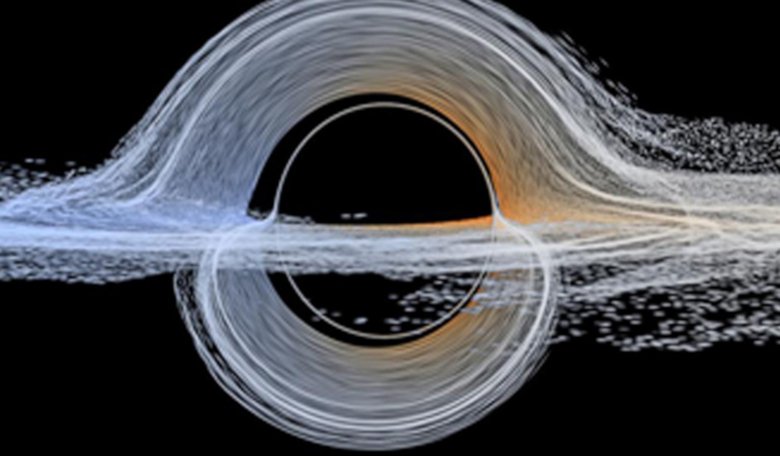For the last 50 years scientists have been proposing methods on how to tap into “free” energy that could be harvested from one of the Universe’s most formidable phenomena - a black hole. Now, in a study published in the journal Physical Review, two researchers are suggesting that by breaking and rejoining magnetic field lines near the event horizon, a source of power could in the future be extracted to support the needs of an advanced civilisation.
Mining energy from black holes may sound like the stuff of science fiction, but it is in fact one of Einstein’s more fanciful-sounding predictions from his theory of General Relativity.
Over the years, some of the greatest minds of physics such as Stephen Hawking and Roger Penrose have looked into how it might be possible to tap into this energy for use one day as a potential power source.
Hawkings for example suggested that black holes could release energy through quantum mechanical emission, while Penrose, in his Penrose process work, theorised that particle disintegration in a region outside of a black hole could be used to gather energy.
This region is known as the ergosphere and is derived from the Greek word ergon, meaning "work”.
Ergospheres are only found around rotating black holes, not stationary ones and these zone are in additional to the event horizon – the "point of no return” – an area surrounding a black hole that marks where the escape velocity is equal to the speed of light.
Like Penrose, Luca Comisso, research scientist at Columbia University and Felipe Asenjo from Universidad Adolfo Ibáñez in Chile, suggest that ergospheres are the place to harvest vast amounts of energy stored around these monstrous objects.
“Black holes are commonly surrounded by a hot 'soup' of plasma particles that carry a magnetic field,” says first author on the new study, Comisso. “Our theory shows that when magnetic field lines disconnect and reconnect, in just the right way, they can accelerate plasma particles to negative energies and large amounts of black hole energy can be extracted.”
In their theory, Comisso and Asenjo state that when the reconnecting magnetic fields accelerate plasma particles in two different directions, one plasma flow is pushed against the black hole's spin, while the other is propelled in the spin’s direction.
Particles following the spin direction can escape the clutches of the black hole, which releases power if the plasma swallowed by the black hole has negative energy.
“It is like a person could lose weight by eating candy with negative calories,” Comisso said, who explained that essentially a black hole loses energy by eating negative-energy particles.
This might sound weird, he said, but it can happen in the ergosphere, where the spacetime continuum rotates so fast that every object spins in the same direction as the black hole.
Inside the ergosphere, magnetic reconnection is so extreme that the plasma particles are accelerated to velocities approaching the speed of light, added Comisso.
The high relative velocity between captured and escaping plasma streams is what allows the proposed process to extract huge amounts of energy from the black hole, explained coauthor on the study, Asenjo.
The duo’s calculations showed that the process of plasma energisation can reach an efficiency of 150 percent and was possible because black holes leak energy, “which is given away for free to the plasma escaping from the black hole,” Asenjo said.
This is much higher than any power plant operating on Earth and one day this energy could be the answer to our future power needs, say the authors.
“Thousands or millions of years from now, humanity might be able to survive around a black hole without harnessing energy from stars,” Comisso said. “It is essentially a technological problem. If we look at the physics, there is nothing that prevents it.”
Long before humanity works out how to technologically harness the power, the process of energy extraction envisioned by Comisso and Asenjo might, in the meantime, aid astronomers to better estimate the spin of black holes, say the authors, as well as help understand what drives powerful bursts of radiation released from black holes that can be detected from Earth.
“Our increased knowledge of how magnetic reconnection occurs in the vicinity of the black hole might be crucial for guiding our interpretation of current and future telescope observations of black holes, such as the ones by the Event Horizon Telescope,” Asenjo said.
Speaking of Comisso and Asenjo work, Vyacheslav Lukin, a program director at the National Science Foundation, who along with NASA, and Chile’s National Fund for Scientific and Technological Development funded this study, said: “The ideas and concepts discussed in this work are truly fascinating. We look forward to the potential translation of seemingly esoteric studies of black hole astrophysics into the practical realm."
The study, Magnetic reconnection as a mechanism for energy extraction from rotating black holes, can be found here.











